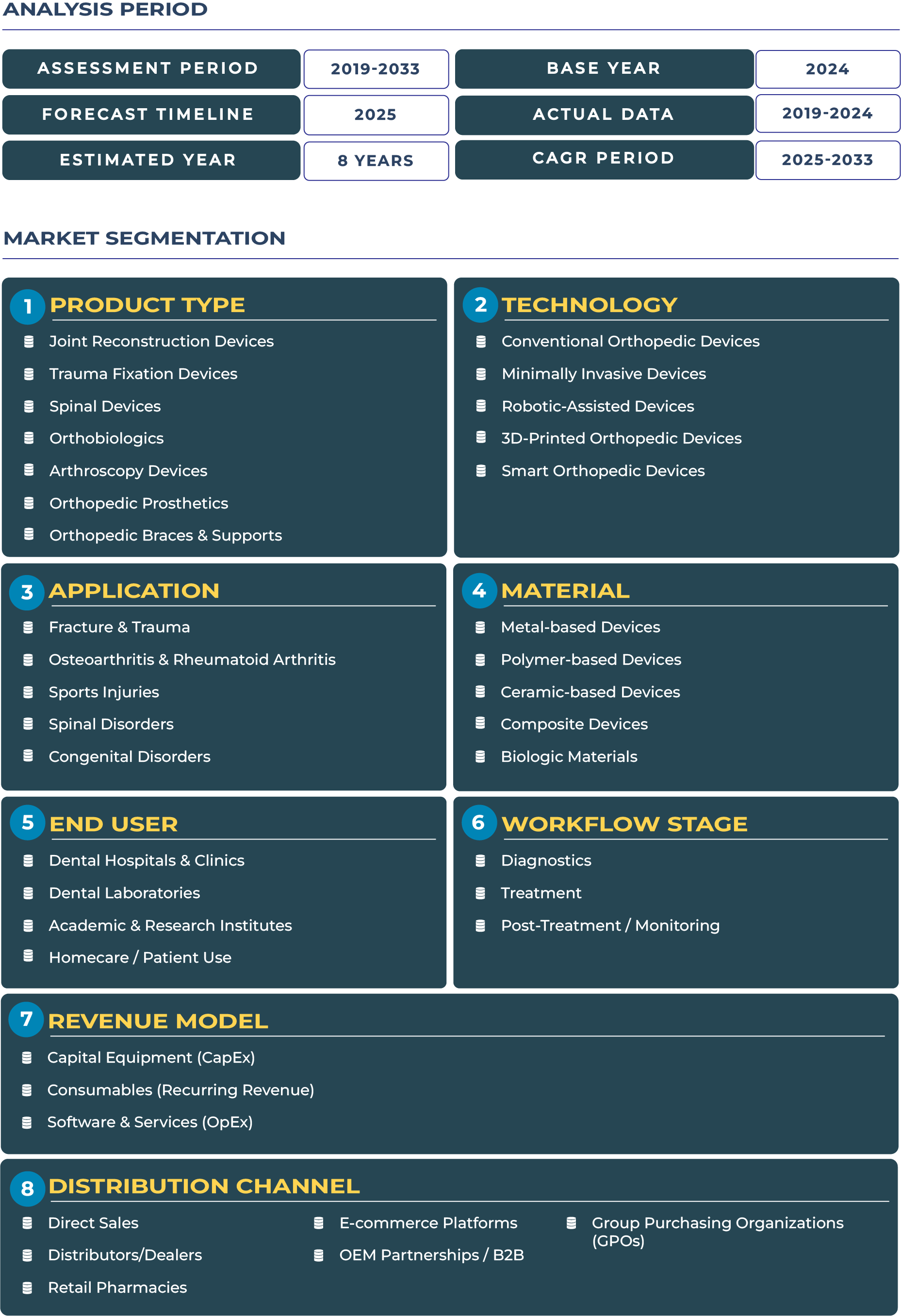South Korea Orthopedic Devices Market Outlook: Blending Technology and Healthcare Innovation for Future Growth
South Korea has established itself as one of the most technologically advanced nations, and this capability is now shaping the future of orthopedic healthcare. The country Orthopedic Devices market is strongly supported by its medtech innovation ecosystem, where robotics, AI-driven surgical navigation systems, and smart implants are moving from pilot adoption to widespread integration. Hospitals across Seoul, Busan, and Incheon are leveraging this technology-first healthcare culture, enabling more efficient surgical outcomes and faster patient recovery. This unique combination of advanced medical infrastructure and strong government backing positions South Korea as a significant contributor to the global orthopedic devices industry.
The South Korea orthopedic devices market is projected to grow from USD 1.04 billion in 2025 to USD 2.01 billion by 2033, at a CAGR of 8.5% from 2025–2033. This expansion is driven by rising cases of musculoskeletal disorders, aging demographics, and early adoption of advanced treatment modalities such as robotic-assisted surgeries and customized joint reconstruction devices. South Korea’s strong private hospital network and government support for digital health innovation are strengthening the ecosystem. Despite global uncertainties due to geopolitical tensions in East Asia and economic volatility from global trade slowdowns, the orthopedic devices landscape in South Korea remains resilient. The nation’s growing investments in minimally invasive surgery technologies and research-driven implant design offer a sustainable pathway for long-term growth. Medical tourism further amplifies demand, as South Korea positions itself as a regional hub for orthopedic care excellence.
Drivers and Restraints: Key Forces Shaping the South Korea Orthopedic Devices Ecosystem
Advanced hospital infrastructure and high-tech adoption drive orthopedic device uptake
South Korea is home to some of the most advanced hospital systems in Asia, with large institutions such as Ministry of Health and Welfare supporting digital healthcare expansion. The integration of high-tech surgical devices like robotic spine systems, navigation-enabled trauma fixation devices, and minimally invasive arthroscopy systems has accelerated adoption across Tier-1 hospitals. Local R&D strength, supported by government-backed medtech programs, ensures rapid co-development of orthopedic solutions that meet patient-specific needs. These factors collectively support robust adoption and export opportunities in the orthopedic devices sector.
Challenges in affordability, local competition, and market scalability hinder growth
While demand is strong, South Korea Orthopedic Devices industry faces restraints linked to its relatively small population base, creating limits on scale compared to larger markets. Additionally, pricing pressures from insurers and public healthcare programs pose challenges for premium implants and advanced spinal devices. Intense competition from domestic OEMs producing cost-effective alternatives impacts foreign players’ penetration. Moreover, reimbursement restrictions for advanced implants such as smart prosthetics limit faster adoption across mid-tier hospitals. These challenges require companies to balance innovation with cost optimization strategies to achieve market competitiveness.
Trends and Opportunities: Unlocking New Growth Pathways in the South Korea Orthopedic Devices Landscape
Smart implants, robotics, and medical tourism redefining orthopedic treatment pathways
South Korea is rapidly becoming a leader in deploying smart orthopedic implants embedded with sensors to track healing and patient outcomes. Robotics-assisted joint reconstruction and spinal surgeries are becoming standard in urban hospitals, positioning the nation as a hub for high-tech orthopedic care. Medical tourism in Seoul and Busan is thriving as international patients seek advanced orthopedic procedures at competitive prices. This aligns with South Korea’s positioning in the broader Asia-Pacific orthopedic devices market as a regional center of excellence for technologically advanced care.
Collaborative R&D, export-driven manufacturing, and KOL-driven adoption create opportunities
Opportunities for orthopedic device manufacturers in South Korea are strongly aligned with co-developing advanced implants with local research institutes and leveraging Korea’s strong innovation ecosystem. Companies are investing in export-ready product lines tailored for Southeast Asia, Middle East, and Europe. Additionally, local Key Opinion Leaders (KOLs) from leading hospitals play a pivotal role in shaping adoption of advanced trauma fixation devices and orthobiologics. This structured collaboration between global manufacturers, local OEMs, and clinical experts is creating a multiplier effect, positioning South Korea as both a consumption and innovation hub in the orthopedic devices industry.
Competitive Landscape: Strategic Collaborations and Technology-First Expansion Shape the Market
The competitive environment in the South Korea orthopedic devices market is defined by both international giants and domestic leaders. Companies such as Medtronic, Smith+Nephew, and Johnson & Johnson compete alongside strong local players like Corentec and CGBio. In 2024, domestic manufacturers increased exports of trauma fixation devices and spine implants, while international players invested in robotic surgery partnerships with South Korean hospitals. Strategies such as co-developing next-generation implants with local OEMs, sponsoring orthopedic centers of excellence, and expanding export lines through regional partners are becoming mainstream. This dual strategy of technology infusion and local alignment ensures competitive positioning in a market that thrives on both innovation and affordability.







